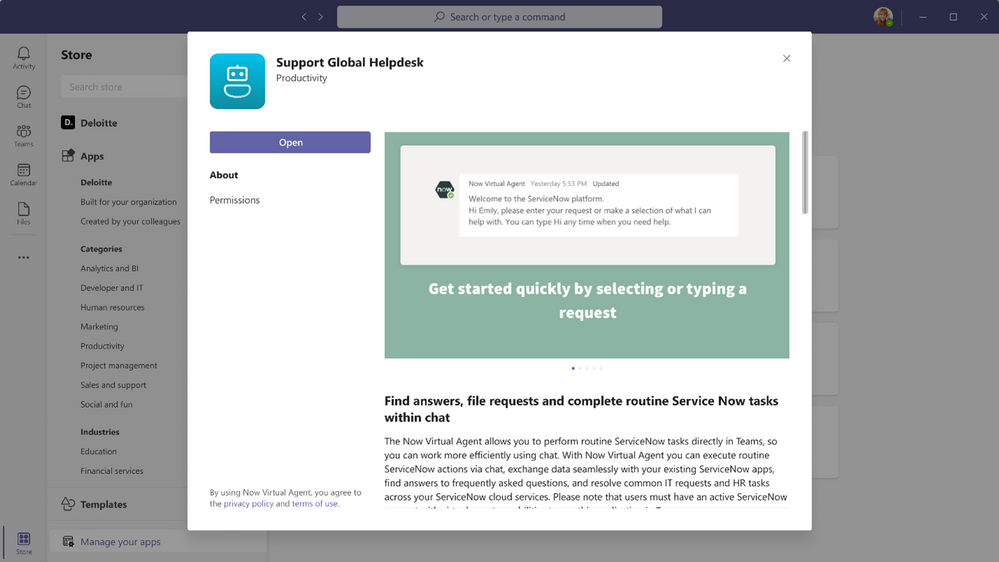
by Contributed | May 21, 2021 | Technology
This article is contributed. See the original author and article here.

In April, we announced our first ever Azure Fundamentals specialization on Coursera’s platform. Today, we are excited that AI Fundamentals and Data Fundamentals are now live on Coursera and a part of the Microsoft Azure Learning Collection. These new Specializations come amid rapid cloud adoption and offer students a strong set of skills that are in high demand in today’s workforce. In fact, according to Burning Glass, the number of Azure-related jobs is projected to grow 38 percent over the next ten years.
What skilling content is included in the new Microsoft Azure AI and Data Specializations?
Microsoft AI Fundamentals: In this Specialization, students can gain foundational knowledge about core artificial intelligence (AI) concepts and become familiar with services in Microsoft Azure that can be used to create AI solutions. Upon completing the Specialization, students will be prepared for the Microsoft Certified AI-900 Azure Fundamentals Exam. Here is a preview of the courses offered in the AI Fundamentals Specialization:
- Artificial Intelligence: learn the key AI concepts of machine learning, anomaly detection, computer vision, natural language processing, and conversational AI.
- Machine Learning: learn how to use Azure Machine Learning to create and publish models without writing code.
- Computer Vision: learn how to use the Computer Vision service to analyze images.
- Natural Language Processing: learn how to use the Text Analytics service for advanced natural language processing of raw text for sentiment analysis, key phrase extraction, named entity recognition, and language detection.
- Preparing for AI-900 Microsoft Azure AI Fundamentals Exam: test your knowledge in a series of practice exams mapped to all the main topics covered in the AI-900 exam, ensuring you are well prepared for certification success.
Microsoft Data Fundamentals: In this Specialization, students can learn directly from Microsoft Azure experts about the core database concepts in a cloud environment. Students will build foundational knowledge of cloud data services within Microsoft Azure, and prepare for the Microsoft Data Fundamentals DP-900 exam. Here is a preview of the courses offered in the Data Fundamentals Specialization:
- Explore Core Data Concepts: learn the fundamentals of database concepts in a cloud environment, get basic skilling in cloud data services, and build your foundational knowledge of cloud data services.
- Azure SQL: learn about SQL and see how it is used to query and maintain data in a database, and the different dialects that are available.
- Azure Cosmos DB: explore non-relational data offerings, provisioning and deploying non-relational databases, and non-relational data stores with Microsoft Azure.
- Modern Data Warehouse Analytics: learn about the processing options available for building data analytics solutions in Azure and explore Synapse Analytics, Databricks, and HDInsight.
- Preparing for DP-900 Microsoft Azure AI Fundamentals Exam: test your knowledge in a series of practice exams mapped to all the main topics covered in the DP-900 exam, ensuring you are well prepared for certification success.
Scholarship opportunities for Women in Cloud
As a part of this initiative, we are teaming up with Women in Cloud to offer their members over 600 scholarships to all three specializations and the respective certification exam vouchers at no cost.
“Digital skilling is becoming a critical necessity in today’s world and women are struggling to get access to career building education. That is why we are excited to partner with Microsoft and Coursera on this special initiative,” said Women in Cloud President Chaitra Vedullapalli
Applicants who are accepted into this program will enroll in and complete the three Azure digital skilling Specializations via the Coursera platform: Azure Fundamentals, AI Fundamentals and Data Fundamentals. What’s more, scholars who complete these trainings will also receive a certification voucher for each Specialization to take the respective exams for free. In addition to free Azure skilling, scholars can also expect career support from the Women in Cloud community. Microsoft, Women in Cloud, and Coursera are committed to equipping women interested in upskilling and contributing to an inclusive, skills-based economy.
Enroll in the AI Fundamentals and Data Fundamentals Specializations today!

by Contributed | May 21, 2021 | Technology
This article is contributed. See the original author and article here.
Microsoft Teams provides the a customized experience for customers, not only enabling them to pick and choose the apps they can allow in their tenant but also providing the capability to rebrand apps in order to integrate them completely in their ecosystem.
When an app publisher publishes an app to the global app store, they do so generically – the app that they’ve built looks and feels the same for all customers who use it. But customers often take these publicly available apps and integrate them into internal business processes so completely that they want their users to see the apps as an extension of other internal tools – they want any seams between internal processes and tools and external tools to be invisible to their employees. This introduces a need for app branding configuration, where customers can take apps that are published to the global store and re-brand them as internal tooling. Doing so reduces roadblocks in users’ cognitive understanding and adoption of the app, and reduces enterprises’ reticence to adopt 3P apps.
Today, some customers build custom apps in order to re-brand the available third-party apps which is not an optimal experience. With app customization, admins will be able to simply customize the available third-party and Microsoft apps through Teams admin center and publish it to their users in a few friendly experience steps.
The app customization feature allows developers to specify which properties of the app can be customized by the tenant. Admins can then rebrand or customize these properties in their Teams Admin Center as per their tenant’s requirements.
How should developers use it?
App developers with customers’ requirement around re-branding the app can now opt in by specifying the properties of the app that can be customized by their customers. App developers can allow one or more of the following properties to be customized by enabling it in the app manifest: Short name, Short description, Full description, Website URL, Terms of use URL, Privacy policy URL, Color icon, Outline icon, Accent color.
Once enabled, the developers can submit the updated manifest for their customers to adopt. Please refer the link to learn more.
How should admins use it?
Admins can now discover the apps that allow customization directly from the Manage apps page in Teams admin center. We have added a new Customizable column which indicates whether an app can be customized. ‘Yes’ tag will be presented for all apps that are allowed to be customized by the app publisher.

The Customize button on the top bar of the App Catalog page will be activated if the developer has offered customization.
This will open a side panel that will have all the app properties that can be customized by the app publisher. Admins can customize the app directly from the side panel on the Manage apps page.
Admins can also access this side panel using the Customizable icon on the widget on the App details page or using the Customize button under the Actions button on the top right of the App details page.

After customizing the properties, the updated values will immediately show up on the app details page and within 24 hours to the end users in the tenant.


We would like more and more apps to be able to utilize the App customization feature. If you would like to enable the feature for your app, please refer to the developer docs for more information. You can learn more about the feature by referring to the admin docs.
Tell us what you think
We value your feedback. If you have any questions, you can refer the FAQs or you can reach out to us on Microsoft Q&A or Stackoverflow.
References
Developer docs: Update manifest with App customization changes
Admin docs: Customize Microsoft apps in Teams – Microsoft Teams | Microsoft Docs
Tarun Singh and Sukhmani Lamba, Program Managers – Microsoft Teams

by Contributed | May 21, 2021 | Technology
This article is contributed. See the original author and article here.
All,
We have partnered with Event Builder to advertise our upcoming events. Thru these new Calendar links, you can now register for multiple events at once and you can now also register for past events to view the recordings! Not all past sessions are available, but going forward if you miss a session you wanted to attend, you can now watch the presentation offline.
https://MTT.eventbuilder.com/MTTUSCANADA
https://MTT.eventbuilder.com/MTTEUROPE
https://MTT.eventbuilder.com/MTTLATAM
https://MTT.eventbuilder.com/MTTAPAC (Events coming Soon)

by Contributed | May 21, 2021 | Technology
This article is contributed. See the original author and article here.
I saw in several situations that our customers are trying to use applicationIntent=Readonly parameter in their connectionstring, but, I would like to mention that this only applies when you have available and enabled ReadScale in Business Critical, HyperScale or Premium database tier.
If you using ApplicationIntent=ReadOnly for database tiers, like basic, standard or general purpose the connection will be possible, but, instead of connecting to the read only replica will be directly to the primary one in readwrite model.
Enjoy!

by Contributed | May 21, 2021 | Technology
This article is contributed. See the original author and article here.

Azure VM: Log in with RDP using Azure AD
George Chrysovalantis Grammatikos is based in Greece and is working for Tisski ltd. as an Azure Cloud Architect. He has more than 10 years’ experience in different technologies like BI & SQL Server Professional level solutions, Azure technologies, networking, security etc. He writes technical blogs for his blog “cloudopszone.com“, Wiki TechNet articles and also participates in discussions on TechNet and other technical blogs. Follow him on Twitter @gxgrammatikos.

Discover sensitive Key Vault operations with Azure Sentinel
Tobias Zimmergren is a Microsoft Azure MVP from Sweden. As the Head of Technical Operations at Rencore, Tobias designs and builds distributed cloud solutions. He is the co-founder and co-host of the Ctrl+Alt+Azure Podcast since 2019, and co-founder and organizer of Sweden SharePoint User Group from 2007 to 2017. For more, check out his blog, newsletter, and Twitter @zimmergren

ASP.NET MVC: HOW TO CREATE MULTIPLE CHECK BOXES WITH CRUD OPERATIONS
Asma Khalid is an Entrepreneur, ISV, Product Manager, Full Stack .Net Expert, Community Speaker, Contributor, and Aspiring YouTuber. Asma counts more than 7 years of hands-on experience in Leading, Developing & Managing IT-related projects and products as an IT industry professional. Asma is the first woman from Pakistan to receive the MVP award three times, and the first to receive C-sharp corner online developer community MVP award four times. See her blog here.

How to create an improved Microsoft Teams Files approval process using Azure Logic Apps
Vesku Nopanen is a Principal Consultant in Office 365 and Modern Work and passionate about Microsoft Teams. He helps and coaches customers to find benefits and value when adopting new tools, methods, ways or working and practices into daily work-life equation. He focuses especially on Microsoft Teams and how it can change organizations’ work. He lives in Turku, Finland. Follow him on Twitter: @Vesanopanen

Teams Real Simple with Pictures: Parallel Approvals in Microsoft Teams
Chris Hoard is a Microsoft Certified Trainer Regional Lead (MCT RL), Educator (MCEd) and Teams MVP. With over 10 years of cloud computing experience, he is currently building an education practice for Vuzion (Tier 2 UK CSP). His focus areas are Microsoft Teams, Microsoft 365 and entry-level Azure. Follow Chris on Twitter at @Microsoft365Pro and check out his blog here.










Recent Comments